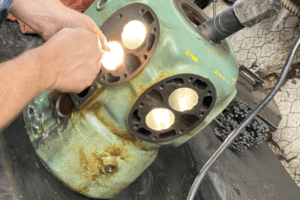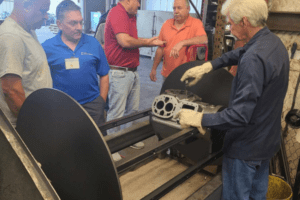Carrying out the recommended preventive maintenance activities is critical to the optimal operation of commercial milk cooling equipment, and avoiding unnecessary downtimes and service calls. Regular maintenance also helps to reduce the likelihood of milk cooling and refrigeration equipment suffering a major breakdown or permanent damage.
As a dairy manager, it is important to not only know how the milk cooling system works but also the recommended inspection and service that should be carried out to keep it running at maximum efficiency.
Below is an overview of the major issues that milk cooling and refrigeration systems can encounter when not regularly maintained:
Leaking and Inefficient Milk Cooler
The milk cooler can start leaking or become energy inefficient when it is not maintained as recommended by the manufacturer. It is important to inspect various parts of the milk cooler like your commercial compressor to ensure they are functioning properly.
Check the agitator motor for noisy operation or grease leaks, as well as worn out shaft bearings and shields. Any worn-out shaft bearings and shields and leaking agitator motor seals should be replaced. Also, tighten the bolts holding the motor mounting brackets.
Malfunctioning Refrigeration Unit
The refrigeration unit should be inspected regularly to ensure the tubing, condenser, refrigerant, compressor and condenser fan motors are in good condition.
Inspect the condenser coil for dust or dirt. Make sure that air flows freely through the coil and exits into the atmosphere. If the condenser coil is dirty, you can easily clean it in a few minutes. Simply turn the disconnect switch to “off” and brush-wash the coil with mild detergent solution. After that, rinse the coil with tap water from the fan side, letting it drain for three hours before restarting the refrigeration unit.
Inefficient Vacuum Pump
The vacuum pump should also be checked occasionally to ensure it is working properly. Here are some suggested routine maintenance activities:
i) The capacity of the pump
Every six months, check the capacity of the pump with a flow meter for signs of stoppage, leaks, or wear in the system.
ii) Check the exhaust pipe
Make sure that the exhaust pipe is not smaller than the pump outlet. Otherwise, there will be a lot of pressure generated, which will limit the performance of the vacuum pump.
iii) Is the vacuum pump clean?
Check the cleanliness of the vacuum pump once every six months, or when the pump is fouled by milk. The vacuum pump should be cleaned using diesel or a 4:1 kerosene-oil mixture. If the pump is very dirty, you can fill it with the mixture and let it soak for a few hours before cleaning.
iv) Check the type and tension of the belts
Spin the pump by hand to check for signs of unusual drag, rough bearings, or loose pulleys. Confirm that the vanes fall freely and that the pulleys are in line.
v) Checking the oil level
Every week, check whether the vacuum pump has the correct type and amount of oil recommended by the manufacturer. Do not overfill the vacuum pump as the excess oil can blow out the exhaust.
Avoid High Repair Costs with Preventive Maintenance
Immediately your milk cooling plant is in operation, implement an effective maintenance program to ensure optimal output is maintained.
Check that the equipment items are well spaced to make it easier for the operation and replacement of components. The milk cooling and refrigeration system should be installed in a room designed to make it easy to remove any item of the equipment at a future date.
If you realize that these objectives have not been met, then the building or the equipment layout may have to be modified early on before a breakdown makes the work necessary. At this time, the repair problem would have escalated, and operations may be significantly delayed before normal output is restored.
A properly planned maintenance program will help to prevent the milk cooling and refrigeration system from breaking down. While you cannot anticipate every failure, regular inspection and service will go a long way in preventing serious failures of the system during operations in your dairy plant.
Renewable components, such as rubber seals and joint rings, should be replaced routinely according to the system manufacturer’s recommendation. It is also important to know the necessary supply of spare parts in advance to simplify the store control procedures.
However, despite carrying out comprehensive preventive maintenance, the cooling plant may fail. System breakdowns can be a result of incorrect assembly, faulty components, operational procedure failures, or other unforeseen causes. Such breakdowns lead to loss of output. Moreover, if the breakdown cannot be repaired within a few hours, substantial losses will occur, and the next day’s operations may be jeopardized. Therefore, it is important to plan a maintenance program for your milk cooling system in advance in the original planning of the plant.












